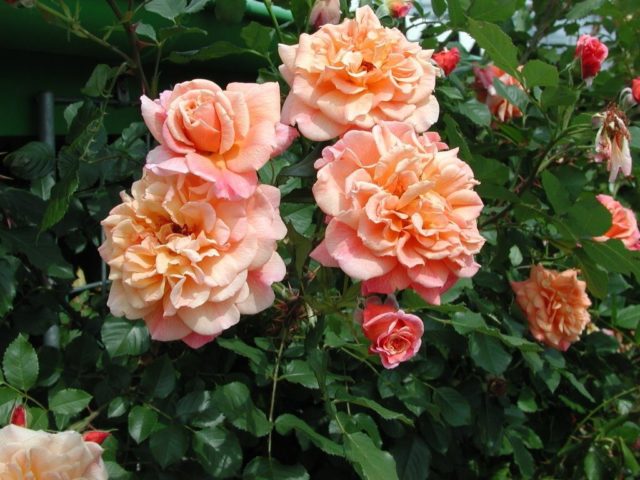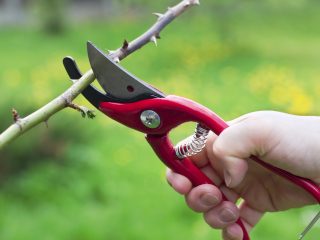Content
Rose Aloha is a variety of climbing roses, distinguished by lush buds and persistent variegated apricot-pink color. The plant has high winter hardiness and relatively strong immunity to insects and flower diseases. Shrubs of this variety, with proper care, tolerate poor soils and are ready to be cut for a long time.
History of selection
The history of breeding the Aloha variety goes back decades. The first version of the hybrid was released in 1949. Its appearance occurred thanks to American gardeners. In Europe, roses from the USA are not popular - a local analogue was bred in Germany.
The preparation of the plant and the development of hybrids of the new Aloha were carried out by a popular company specializing in the selection and production of roses - Wilhelm Cordes and Sons. The result was ready by 2003 - Aloha was registered as a new variety. In the official list the variety has several names:
- Aloha;
- Kordes Rose Aloha;
- Aloha Hawaii;
- Korwesrug.
Both varieties, bred in 1949 and 2003, belong to climbers - roses with large inflorescences, tough shoots and repeated flowering throughout the warm season.The main difference between the two hybrids is the color and shape of the bud. The old version of Aloha has delicate pink petals and a cupped or rounded outline.
Description and characteristics of the climbing rose variety Aloha
Aloha 2003 differs from its predecessor primarily in appearance. Large bright buds of a classic shape reminiscent of Bourbon bloom from orange-yellow inflorescences. The average size of a rose is 8-10 cm. The color of the grown flowers is variegated, two-tone: contains an apricot tint.
The Aloha plant as a whole is a rose bush with a height of 2.5 to 3 m. The width reaches 2 m. The foliage is smooth, dense and dense, and has a bright green color. The shoots are distinguished by their rigidity and many thorns. The aroma of the flowers is pleasant, rich, and contains fruity notes. The plant is ready to be cut for a long time and can please the eye of the owner of the house.
The variety develops continuously throughout the summer season: on average, from May to September. Due to the gradual and alternate opening of the buds, flowering periods are difficult to distinguish. This characteristic makes Aloha a frequent guest in landscape design projects. Roses throughout the warm period delight the eye of the owner of the site without losing their color.
Roses are propagated by cuttings. All qualities inherent in the Aloha variety will be preserved under the condition of vegetative transplantation of the plant. Usually, strong, stable bushes become donors after the first wave of flowering.

It will be more convenient to care for roses with specialized gloves to protect your hands from thorns
Advantages and disadvantages of the variety
The Aloha rose variety has many characteristics that should be taken into account when planting in your garden.First of all, it is important to note the advantages of the variety:
- The long, smooth and abundant flowering period allows Aloha to be called a truly ornamental plant. Its colorful buds can delight the owner with their beauty and scent all summer long.
- Roses are unpretentious and highly resistant to diseases and pests. Aloha is not afraid of black spot and insects, but if not properly cared for it can be susceptible to illness.
- Winter hardiness. Aloha survives cold temperatures down to -8 degrees in a well-designed shelter.
But Aloha also has disadvantages regarding both its main function - decorativeness and plant care.
- Quite large and heavy flowers often sag under their own weight, losing their climbing ability. In order for the variety to serve as a good decoration, it is important to carefully support and strengthen the plant.
- The need to care for the soil. The rose is unpretentious and disease-resistant, but due to its steadfastness it requires careful care of the soil. Thanks to fertilizing the soil once every 2-3 weeks, Aloha is able to grow properly and not cause trouble for the gardener.
- Due to the large number of thorns, roses are inconvenient to replant, prune, or wrap for the winter.
Even the need for fertilizer should not frighten off an experienced and inquisitive gardener who wants to decorate his plot. The Aloha rose is truly worth the effort it takes to grow it and is relatively low hassle.
Growing and care
The main requirement for abundant and healthy flowering of the Aloha variety is fertile soil. To achieve the maximum effect from an ornamental plant, it is important to comply with all the conditions for planting a bush. It is worth giving the characteristics of the optimal environment for growing roses.
- A thoroughly sunny area.The best position for Aloha will be the northeast side of the garden away from tall objects. Roses love light, but in the evening they prefer shading. A good way to provide the plant with protection from the sun is through the canopy of trees.
- No drafts or strong winds. Roses prefer to grow in calm areas, and sudden gusts of air can cause Aloha to grow poorly.
- Full supply of nutrients. Aloha is a large bush, so the necessary minerals reach the appendages with difficulty. Fertilizer is an integral part of variety care.
If a suitable plot of land does not have nutritious soil, then it is worth resorting to a complete replacement of the soil. All unsuitable soil must be removed from the 50x50x50cm hole. This planting area is filled with fertile imported black soil.

Aloha tolerates even harsh Siberian winters: the snow cover acts as an additional protection for the delicate rose
If it is not possible to bring soil, the land is prepared for planting by adding some ingredients. The following will help improve the condition of the soil:
- Clay;
- Humus;
- Superphosphate;
- Potassium salt.
It is the preparation of the soil for Aloha to live in it that will allow you not to resort to fertilizer over the next 2-3 years. The period from planting to complete germination is the most important for the future condition of the rose. As the bushes grow, the need for additional fertilizer and care becomes less.
The planting hole must be at least 30x30x30 cm in size. Planting occurs from April to May, or in the fall - in September and October. In the first year of Aloha’s life, it is necessary to ensure complete rooting of the bushes.To do this, the initially appearing rose buds are removed, which helps improve the nutrition of the root system.
Watering the bushes is carried out abundantly, but rarely. Young seedlings require water once every 10 days, adults are content with moisturizing once every 15-20 days. In extreme heat, the intervals between waterings are reduced. The amount of liquid varies depending on the size of the plant. For large roses - 3-4 buckets, for small ones - up to 10 liters.
In addition, the Aloha rose requires regular loosening of the soil, getting rid of weeds, pruning shoots and preventing possible diseases. Removal of buds that appear in the spring is carried out depending on the purpose of forming the bush.
- Heavy pruning is necessary to rejuvenate wilted bushes.
- The middle one is produced to ensure abundant and early flowering.
- Light pruning is used in the summer to remove old inflorescences.
In order for Aloha to survive the winter, it is not necessary to cover it - frost resistance reaches -8 degrees without additional protection. It is worth taking care of the safety of flowers only during severe frosts. When cold weather sets in, it is important to trim the bushes and hill up the plant. A frame is built around the rose, which is covered with material to calmly await the warm period. With the arrival of spring, Aloha is gradually ventilated - the side walls of the protective structure open.

Feeding roses depends on the time of year: in spring Aloha needs nitrogen, in summer – phosphorus and potassium
Pests and diseases
Some gardeners note that the Aloha rose is susceptible to attack:
- Spider mites;
- Black spot;
- Rust;
- Powdery mildew;
- Aphids;
- Sawflies;
- Leaf roller.
This can only happen if all necessary preventive and care measures are not followed.Otherwise, the rose is unpretentious and does not react to illnesses. Aloha has a strong immune system and prefers not to be capricious if its gardener responsibly complies with all requirements and carefully fertilizes the plant.
Application in landscape design
Aloha can decorate an area by itself without additional processing: its bright green foliage with unusually colored flowers looks good in its pure form. Large delicate buds with a pleasant fruity smell will be an excellent decoration for any area. The rose harmonizes perfectly with arches and columns. The structures are entwined with shoots and acquire natural beauty. Thanks to the climbing nature of the shoots, the rose effectively grows over any frame, becoming a hedge or small decoration. Vertical gardening also helps hide defects on the walls of buildings.
Conclusion
The climbing rose Aloha evokes positive reviews from most gardeners; the photo and description of the grown plant gives them a reason to be proud of their garden. Most flower connoisseurs confirm the variety’s unpretentiousness and ease of care. Delicate and fragrant, the rose will delight any summer resident who is in love with the beauty of nature and wants to make the site better.








